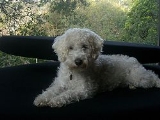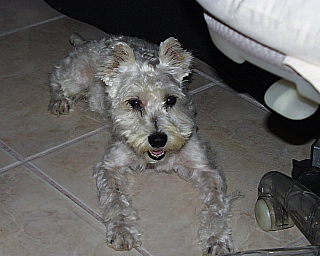
Schnoodle
Encyclopedia
A Schnoodle is a domestic dog. It is a cross
between a Schnauzer
and a Poodle
. Schnoodle is a portmanteau word combining the two breed names.
 Poodles come in four different sizes, Standard, Medium, Miniature and Toy, or three sizes, Standard, Miniature, and Toy, depending on where they are registered. Schnauzers come in three sizes, Standard Schnauzer
Poodles come in four different sizes, Standard, Medium, Miniature and Toy, or three sizes, Standard, Miniature, and Toy, depending on where they are registered. Schnauzers come in three sizes, Standard Schnauzer
(the original), Giant
, and Miniature
. The Schnoodle is usually a cross of the smaller sizes. 7–16 pounds is typically the size implied when an owner speaks of a Schnoodle, but a puppy buyer must visit the breeder's kennel and see the parents to get an idea of the adult size of their Schnoodle. The Schnoodle may take on the rough hair and strong body shape of the Schnauzer, or the thinner shape and the curly hair of the poodle, or a combination of characteristics.
, Schnoodles are "rising to canine stardom"
Legitimate breed associations such as the AKC, the UKC, and the CKC, do not recognize the Schnoodle, or any other designer cross, as a breed. As with other designer crosses, the popularity of Schnoodles has led to a rise in puppy mill
s selling the breed.
 A puppy can take on the coat characteristics of either breed, such as developing the rough and coarse/wiry hair of the Schnauzer, the softer hair of the Poodle, or any intermediary type coat. Some schnoodles develop coarser Schnauzer-like hair on certain parts of the body (most notably the back) with other softer Poodle-like areas. Schnoodle colors include black, white, brown, grey and apricot. Multi-colored dogs can include "phantom," which takes on the coloring of a doberman, black & white, sable or parti.
A puppy can take on the coat characteristics of either breed, such as developing the rough and coarse/wiry hair of the Schnauzer, the softer hair of the Poodle, or any intermediary type coat. Some schnoodles develop coarser Schnauzer-like hair on certain parts of the body (most notably the back) with other softer Poodle-like areas. Schnoodle colors include black, white, brown, grey and apricot. Multi-colored dogs can include "phantom," which takes on the coloring of a doberman, black & white, sable or parti.
Puppies in the same litter may have differing coat qualities and may or may not exacerbate allergies. Their fur does not usually shed like other breeds, but grows more like human hair. This requires weekly brushing and grooming every 2 to 3 months to ensure matting does not become an issue. There is no certain "breed" cut for a schnoodle; most dogs receive a general groom with rounded or squared-off semi-long hair left on the face.
, and train easily. Because both poodles and schnauzers are hypoallergenic, or non-shedding, Schnoodle usually have a hypoallergenic coat. The term hypoallergenic though, only means that the dogs dander shedding is minimal.
Since Schnoodles are bred from two intelligent breeds - the poodle and the schnauzer - they are often easy to train as long as they have motivation and are constantly challenged. They need a structured living situation or else they can develop anxiety related behavioral problems.
Crossbreed
A crossbreed or crossbred usually refers to an animal with purebred parents of two different breeds, varieties, or populations. Crossbreeding refers to the process of breeding such an animal, often with the intention to create offspring that share the traits of both parent lineages, or producing...
between a Schnauzer
Schnauzer
A Schnauzer is a German dog type that originated in Germany in the 15th and 16th centuries. The term comes from Schnauze , the German word for "snout", because of the dog's distinctively bearded snout. The word Schnauzer also means moustache in German; some authorities, such as Encyclopædia...
and a Poodle
Poodle
The Poodle is a breed of dog. The poodle breed is found officially in toy, miniature, and standard sizes, with many coat colors. Originally bred as a type of water dog, the poodle is highly intelligent and skillful in many dog sports, including agility, obedience, tracking, and even herding...
. Schnoodle is a portmanteau word combining the two breed names.
Appearance

Standard Schnauzer
The Standard Schnauzer is the original breed of the three breeds of Schnauzer, and despite its wiry coat and general appearance, is not related to the British terriers. Rather, its origins are in old herding and guard breeds of Europe. Generally classified as a working or utility dog, this...
(the original), Giant
Giant Schnauzer
The Giant Schnauzer is a large, powerful, and compact breed of dog. It is one of the three Schnauzer breeds. Like most large breeds, the Giant Schnauzer needs a fair amount of exercise.-Appearance:...
, and Miniature
Miniature Schnauzer
The Miniature Schnauzer is a breed of small dog of the Schnauzer type that originated in Germany in the mid-to-late 19th century. Miniature Schnauzers developed from crosses between the Standard Schnauzer and one or more smaller breeds such as the Poodle and Affenpinscher.The breed remains one of...
. The Schnoodle is usually a cross of the smaller sizes. 7–16 pounds is typically the size implied when an owner speaks of a Schnoodle, but a puppy buyer must visit the breeder's kennel and see the parents to get an idea of the adult size of their Schnoodle. The Schnoodle may take on the rough hair and strong body shape of the Schnauzer, or the thinner shape and the curly hair of the poodle, or a combination of characteristics.
Temperament
The temperament of the Schnoodle is reflective of its Schnauzer and Poodle forebears. The Schnauzer can be affectionate, naturally protective, intelligent and strong-willed; the Poodle is often clever, active, and excels in obedience training. The Schnoodle may inherit any combination of intelligence, personality, temper and protective nature of the parent breeds. They can make good pets and are often devoted and affectionate to their family. Like both parent breeds, Schnoodles are usually active dogs and are impressive runners and jumpers; regular exercise and activity are necessary components of their lives.Hybrid status and recognition
Schnoodles are first-generation crosses, with two purebred parents, one a Poodle and the other a Schnauzer.. According to NewsweekNewsweek
Newsweek is an American weekly news magazine published in New York City. It is distributed throughout the United States and internationally. It is the second-largest news weekly magazine in the U.S., having trailed Time in circulation and advertising revenue for most of its existence...
, Schnoodles are "rising to canine stardom"
Legitimate breed associations such as the AKC, the UKC, and the CKC, do not recognize the Schnoodle, or any other designer cross, as a breed. As with other designer crosses, the popularity of Schnoodles has led to a rise in puppy mill
Puppy mill
A puppy mill, sometimes known as a puppy farm, is a commercial dog breeding facility that is operated with an emphasis upon profits above animal welfare and is often in substandard conditions regarding the well-being of dogs in their care...
s selling the breed.
Coat care

Puppies in the same litter may have differing coat qualities and may or may not exacerbate allergies. Their fur does not usually shed like other breeds, but grows more like human hair. This requires weekly brushing and grooming every 2 to 3 months to ensure matting does not become an issue. There is no certain "breed" cut for a schnoodle; most dogs receive a general groom with rounded or squared-off semi-long hair left on the face.
Hypoallergenic coats
Schnoodles have become more popular as individuals are looking for companion animals that are hypoallergenicHypoallergenic
Hypoallergenic, meaning "below normal" or "slightly" allergenic, was a term first used in a cosmetics campaign in 1953. It is used to describe items that cause or are claimed to cause fewer allergic reactions...
, and train easily. Because both poodles and schnauzers are hypoallergenic, or non-shedding, Schnoodle usually have a hypoallergenic coat. The term hypoallergenic though, only means that the dogs dander shedding is minimal.
Health and Behavior
Like poodles, some schnoodles will develop a large amount of in-the-ear hair. This must be removed by a vet or groomer to prevent fairly persistent ear infections that result. Like both the poodle and schnauzer, the schnoodle may require expression of the anal glands a couple times per year; a vet or groomer can perform this service. As with poodles, it is also a good idea to clean the discharge from under a schnoodle's eyes in order to minimize tear-staining, particularly on animals with a light coat.Since Schnoodles are bred from two intelligent breeds - the poodle and the schnauzer - they are often easy to train as long as they have motivation and are constantly challenged. They need a structured living situation or else they can develop anxiety related behavioral problems.
See also
- Hypoallergenic dog breed
- Poodle hybrids (meaning crossbred dogs, not Poodles bred with foxes or other canids)
- Genetics (basic diagrams of inheritance)

